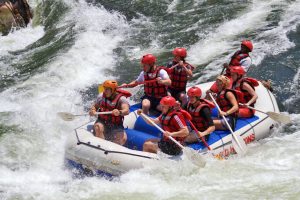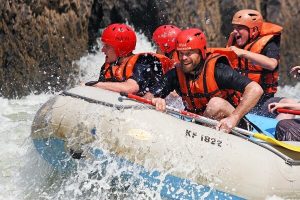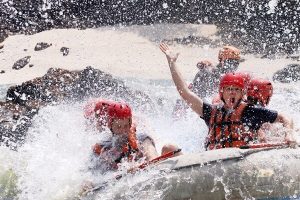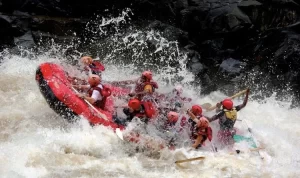Activity Description
There is White Water Rafting, then there is White Water Rafting the Zambezi River. Arguably one of the finest rafting trips on the planet!
Your adventure starts with a decent of several hundred meters, taking you below the mighty Victoria Falls. The largest waterfall in the world with a curtain of falling water stretching over a mile wide! Concentrated and forced through the much narrower Batoka gorge, these gushing waters create some of the most daunting rapids of any river in the world!
Given the sheer power and magnitude of rapidly flowing water, this activity varies greatly depending on the time of year. High water rafting is when the river is at it’ highest and the flowing its fastest, with low water rafting happening during the dry season when the river level has dropped somewhat. Whilst each time of year offer different conditions, it’s still an incredible rafting experience!
High water rafting is the period after the rains have come, and after the flood waters feeding the Zambezi River have reached their peak. This is generally from February through to July. Depending on how good the rainy season has been, this activity often shuts completely for a couple of months when the river is at its highest, usually around May/June. This only happens if there has been a particularly good rainy season and the river is deemed too dangerous to raft. Even then it’s often less than a month. It is also not uncommon to miss out some of the more dangerous rapids during high water due to safety concerns
Low water rafting runs from August through to December. This is considered the dry season in Victoria Falls with little to no rainfall during these months. The river drops significantly during this time making it an amazing rafting experience. All rapids are open, many with added obstacles of exposed rocks usually covered by water during peak season. Not only does low water rafting allow you undisturbed access to the whole river, it is also much more dramatic. During peak season rafting is trying to keep upright on turbulent raging waters. Low water requires more skill and maneuvering as have to pick your routes through rocky channels.
The White Water Rafting Activity is offered in two parts. A full day experience and a half day experience. Each ends with a tough climb out the Batoka gorge. Incredibly beautiful, but certainly requires an element of physical fitness.
White Water Rafting Activity Requirements
Age Limit: 15 years (This can be flexible, at management’s discretion i.e. if the child is of the right maturity, strength and will fit into a life jacket properly then younger children are sometimes accepted.
Minimum Height: No minimum height
Maximum Height: No maximum height
Fitness Level: The walk in and out of the gorge is steep and rocky. The walk out is approximately 750 feet to the top of the gorge and requires a reasonable degree of fitness.
Maximum Weight: No maximum weight.
Experience Level: No Experience Requirement.
Additional Information
Duration: The whole excursion from time of pickup to drop off at your hotel is approximately 6 hours 30 minutes.
Seasonal Activity:
Low Water Rafting
Approximate Dates: 10th August – 25th December
High Water- Rafting Approximate Dates: 25th Dec – 10th August
What to wear: Swimsuit and shorts/cycling shorts but nothing that water will suck away, T-shirt or long-sleeved shirt for sun protection, sturdy shoes/trainers or rafting shoes. Your shoes must be securely fitted to your feet (i.e. no flip-flops) or they will be lost! Wet Suits will be provided in the winter months.
What to bring: Sunscreen and lip balm (guides will have dry bag for this) A peak cap that will fit comfortably under your helmet. Bring as little as possible!
How safe is White Water rafting?
Like any river rafting around the world there is certainly an element of risk jumping into an inflatable boat and navigating turbulent waters. However for the thousands of people who have been on this activity, their percentage of issues is incredibly small.
Not only are you always under the supervision of highly qualified rafting guides (accredited by the international rafting federation), but there are also multiple safety kayakers who join your rafting experience to help pull you back to your raft or to the shore if you seem to be struggling.
Clients are given the option between an “oar boat” and a “paddle boat”.
An “oar boat” is controlled and manoeuvred by the guide using “12 foot-long” oars from the middle of the raft. Guests are seated in the front and rear of the raft and hold on to the safety line around the perimeter.
A “paddle boat” requires the passengers to actively assist the guide in manoeuvring the raft through the rapids and the calm stretches, they are seated around the perimeter of the boat and all paddle, but do not hold onto the safety line.
Whilst there is an element of risk, this activity is open to complete rafting novices, people who have never rafted before join this adrenaline rush and absolutely love it!
What is the difference between White Water Rafting and Canoeing?
The major difference between White Water Rafting and Canoeing is where they take place. Rafting happens below the Victoria Falls, within the turbulent waters of the Batoka Gorge. Canoeing takes place above the Victoria Falls, peacefully navigating your way along the banks of the Zambezi River.
The other major difference is the pace. Canoeing takes you on a scenic drift where the name of the game is to spot wildlife along the shore, and take in sights and sounds around you. Rafting is a fast paced battering as you maneuver your raft over rapids and white waters, trying to stay upright.
In essence whilst both these activities see you board inflatable boats and embark on a voyage on the Zambezi River, that’s where the similarities stop. Completely different experiences from the moment you pick up your paddle.
Inclusions and Exclusions
Included: A mind blowing Zambezi white water rafting trip, transfers from your hotel/lodge , gear, & lunch.
Excluded: National Park fees which are currently US$10pp






Drop us a message ↓
